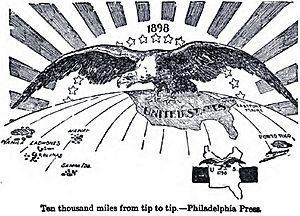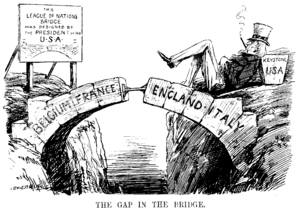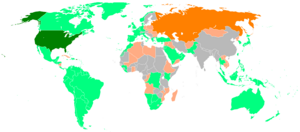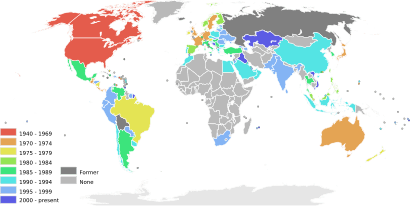Pax Americana facts for kids
Pax Americana means "American Peace" in Latin. It's a term used to describe a time of relative peace and stability in the world, especially after World War II in 1945. During this period, the United States became the world's leading economic and military power.
This term shows how strong the United States became compared to other countries. For example, the Marshall Plan, which spent $13 billion to help rebuild Western Europe after World War II, is seen as the start of this "American Peace."
Contents
How the Idea of American Peace Began
The idea of Pax Americana first appeared after the American Civil War. This war showed that the United States could unite and use a strong military. At this time, the term referred to the peace within North America.
This idea grew along with the concept of American exceptionalism. This is the belief that the U.S. is special among developed nations. It's unique because it's a country of immigrants and was one of the first modern democracies.
From the American Revolution until the Spanish–American War, the United States mostly focused on its own region. The peace that the Union brought to North America helped the country become successful. States within the federal system felt secure. They didn't need large armies or worry about wars stopping trade. The first time "Pax Americana" was written down was in 1894. It described President Cleveland's actions to keep law and order across the country.


At the end of the 1800s, as new empires grew, people in the U.S. debated whether to be imperialist (expand influence) or isolationist (stay out of foreign affairs). "Pax Americana" then meant peace across the U.S. and even across all of the Americas, protected by the Monroe Doctrine.
Some leaders, like Samuel Gompers and Andrew Carnegie, wanted to avoid foreign problems. Others, like Henry Cabot Lodge, William McKinley, and Theodore Roosevelt, wanted a stronger foreign policy. In 1893, U.S. officials helped overthrow the government of the Kingdom of Hawaii. The U.S. later annexed Hawaii in 1898.
After winning the Spanish–American War in 1898, the U.S. gained Cuba, Puerto Rico, the Philippines, and Guam. This made the U.S. a strong regional power and extended its reach into Southeast Asia and Oceania. These new territories helped expand trade with Latin America and Asia. The U.S. created a "sphere of influence" in the Caribbean, meaning it had a lot of control there. This showed that the U.S. was taking on the role of enforcing a "Pax Americana" in these areas.
European powers generally accepted the U.S. actions in the Americas. The growing "Pax Americana" was even helped by the British Empire. Britain's strong Royal Navy controlled the seas and prevented other European powers from interfering in the Americas. This helped protect British trade interests and the growing U.S. economy.
By the late 1800s, the U.S. was no longer just focused on its own region. It adopted protectionism (protecting its own industries) and built a powerful navy, the "Great White Fleet." When Theodore Roosevelt became President in 1901, he pushed for more foreign involvement. The Philippine–American War was part of this. In 1904, the Roosevelt Corollary to the Monroe Doctrine stated that the U.S. could step in to stabilize weak countries in the Americas. This showed the U.S. becoming a regional leader. By 1900, the U.S. had the largest industrial capacity and income in the world.
Between World Wars
After World War I, some people criticized the U.S. for not taking a stronger global leadership role. This was partly because there were no global organizations like the World Bank or United Nations yet. Also, the U.S. had policies like protectionism.
Even though the U.S. joined World War I, President Woodrow Wilson said it was to protect peace and justice. He wanted to create a "concert of free peoples" to ensure peace and safety for all nations.

The U.S. joining WWI meant it was moving away from its traditional policy of staying out of world politics. After the war, some Americans wanted the U.S. to be more active globally. However, the U.S. government chose economic and ideological approaches instead of military ones. Wilson proposed the League of Nations to keep peace, but the U.S. did not join it.
Between WWI and WWII, America still tried to keep "Pax Americana" in the Western Hemisphere. Before 1917, the U.S. officially stayed neutral in WWI. However, many Americans sympathized with the Allied Powers. They disliked Germany's harsh war tactics and saw themselves as protecting peace in the Western world.
The American writer Roland Hugins said that the U.S. was the only strong nation not interested in conquering other lands. He believed Americans wanted to work on their own principles of liberty and democracy. He said the U.S. had a deep dislike for war and didn't want to dominate other people.
The Modern Era of American Peace
The modern idea of Pax Americana refers to U.S. foreign policy after World War II. From 1946 to 1991, it was more of a partial peace, mainly for capitalist countries. Some people call this period Pax Americana et Sovietica because the Soviet Union was also a major power.
Many people focus on U.S. policies from 1992 onward. The term can have different meanings. For example, the Project for the New American Century used it to describe American leadership. Critics use it to say American dominance is like an empire.
From the mid-1940s until 1991, U.S. foreign policy was shaped by the Cold War. The U.S. had a large military presence and was very involved in diplomacy. It adopted a policy called containment to stop the spread of communism.
The modern Pax Americana is often compared to the Pax Romana, a period of peace in the Roman Empire. In both cases, the peace was "relative." Wars still happened, but it was a time of prosperity for their civilizations. This peace meant that their military, agriculture, trade, and manufacturing thrived.
Following Britain's Lead
From 1815 (after the Napoleonic Wars) until 1914 (WWI), the United Kingdom played a similar role in Europe. The British Empire became the largest empire ever. The British military and trade were dominant, and the Royal Navy controlled the world's oceans. It helped stop piracy and slavery. Even during this "Pax Britannica," there were still several wars between major powers.
During Pax Britannica, America and Britain developed a "special relationship." They shared language and history, which brought them together. As the British Empire changed into the Commonwealth of Nations, some British leaders saw Britain's relationship with America like that of ancient Greece to Rome – a teacher to a powerful student. Both nations have been active in North America, the Middle East, and Asia.
Late 20th Century Changes
After World War II, there were no major armed conflicts between the main Western nations. Also, no nuclear weapons were used in open warfare. The United Nations was created after WWII to help keep peace. The U.S. was one of the permanent members of the UN Security Council with veto power.
In the second half of the 20th century, the USSR and the U.S. were in the Cold War. This was a struggle for global influence. After 1945, the U.S. was in a very strong position. It produced half of the world's industrial goods, held 80% of the world's gold, and was the only country with nuclear weapons. The war had greatly weakened the old empires. The U.S. economy and military forces were strong. Military leaders believed that "Pax Americana" relied on strong U.S. air power, just as "Pax Britannica" relied on sea power. After the Soviet Union fell, the U.S. became the single most powerful country.
In the 1960s, John F. Kennedy spoke about "Pax Americana." He argued against a peace based on "American weapons of war." He wanted a true peace that allowed people and nations to grow and build a better life for their children. He wanted peace for everyone, not just Americans.
Around the time of the Vietnam War, critics of American influence started using "Pax Americana" to describe Neocolonialism (new forms of control over developing nations). NATO became a symbol of "Pax Americana" in Western Europe. The Supreme Allied Commander, always an American, had great influence over European leaders.
American Power Today
Today, Pax Americana is based on the U.S. military's unmatched strength. It can project power across the world's oceans, air, and space. This is managed by the Unified Command Plan, which divides the world into regions. The U.S. also has a global network of military alliances (like the Rio Pact, NATO, ANZUS) and hundreds of military bases. These alliances are often seen as systems run by the United States.
Besides military power, the U.S. supports international organizations like the United Nations and WTO with its money and diplomacy. The U.S. invested a lot in programs like the Marshall Plan and rebuilding Japan. This helped strengthen defense ties during the Cold War.
The U.S. also helped create institutions like the International Monetary Fund and International Bank for Reconstruction and Development (World Bank). These were part of the Bretton Woods system for managing international finance. The General Agreement on Tariffs and Trade (GATT) was also developed to reduce trade tariffs.
After the fall of the Iron Curtain and the end of the Cold War, the U.S. kept its military forces in Europe and East Asia. The systems that support "Pax Americana" and U.S. power have continued into the 21st century. However, Americans are often hesitant about foreign wars. Some people want the U.S. to continue its military leadership. They believe "American peace" has brought stability and growth. But others resent relying on American military protection, especially if they disagree with U.S. foreign policy.
Some experts, like Hubert Védrine, describe the U.S. as a "hyperpower." Others, like John Mearsheimer and Joseph Nye, argue that the U.S. is not a "true" global leader because it doesn't have enough resources to control everything. They say the U.S. is economically equal to Europe. Other countries like China, Russia, India, and the European Union are also becoming powerful.
Joseph Nye compared the U.S. to Rome, saying, "Not since Rome has one nation loomed so large above the others." He noted that Rome stayed dominant for over 300 years. There are similarities between the early Pax Romana and Pax Americana. In both cases, other states remained formally independent and were called "friends and allies."
The idea of "Pax Americana" was discussed by the Advisory Committee on Postwar Foreign Policy in 1942. They thought the U.S. might replace the British Empire and "impose our own terms, amounting perhaps to a Pax Americana." The founder of geopolitics, Rudolf Kjellen, also predicted a U.S. global leadership after WWI.
In 1945, Ludwig Dehio noted that Germans used the term Pax Anglosaxonica (meaning Pax Americana) since 1918. He said the U.S. withdrew into isolation then, just as Rome took a long time to understand its world role. Richard von Coudenhove-Kalergi suggested in 1943 that U.S. air power could bring 200 years of peace, like the Pax Romana.
One of the first criticisms of "Pax Americana" came from Nathaniel Peffer in 1943. He said it would require a "gigantic imperialism" and would lead to opposition. He worried that America might "drift into empire."
Later critics, Michio Kaku and David Axelrod, said that "Gunboat diplomacy would be replaced by Atomic diplomacy. Pax Britannica would give way to Pax Americana." After the Cold War, with the Soviet Army gone, Joshua Muravchik titled his 1991 article, "At Last, Pax Americana." He said the Cold War was not a "pax," but now the world was "unipolar" (one main power).
In 1992, a U.S. defense plan was leaked. It aimed to prevent any hostile power from dominating Eurasia. Paul Wolfowitz, who helped write it, said that critics who once laughed at the idea of a "Pax Americana" now seemed comfortable with it. William Wohlforth concluded that the period after the Cold War truly deserves to be called Pax Americana.
The idea of Pax Americana became very popular during the Iraq War in 2003. Many news stories used the phrase "American Empire." Jonathan Freedland noted that the idea of the U.S. as a 21st-century Rome was gaining ground in America. Cartoons showed George Bush as a Roman centurion.
Peter Bender, in 2003, said that when people need a historical comparison for U.S. power, they almost always think of the Roman Empire. He listed many similarities:
- Both expanded for security.
- Both claimed the right to make enemies harmless.
- Both became protectors of other states, gaining control in the process.
- Both saw rivals as rebels or rogue states, fighting to "create peace."
However, some experts like Charles A. Kupchan predicted the "End of the American Era." But in 2012, he still believed America's military strength would be central to global stability.
Russian analyst Leonid Grinin argues that Pax Americana will continue to be important for world order. He warns that its destruction could lead to major global changes.
Ian Bremmer believes that with the election of Donald Trump and the rise of populism, along with the U.S. leaving international agreements, Pax Americana is over.
What is American Imperialism?

American imperialism is a term that describes the cultural and political effects of United States foreign policy. Since the start of the Cold War, the U.S. has supported friendly foreign governments, sometimes even those that violated human rights.
The idea of American imperialism came from critics of capitalism and those who opposed what they saw as aggressive U.S. policies. However, some historians argue that the term "imperialism" is used too often and doesn't always clearly describe U.S. actions.
See also
 In Spanish: Pax Americana para niños
In Spanish: Pax Americana para niños


